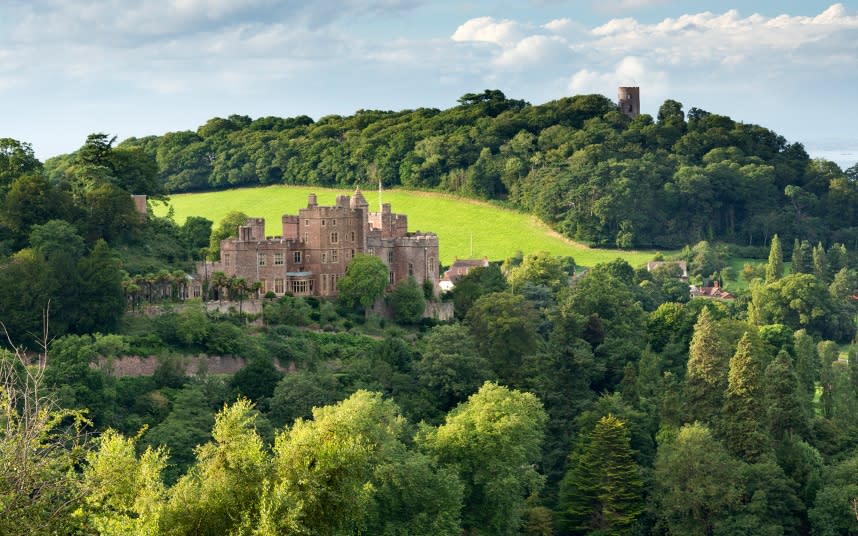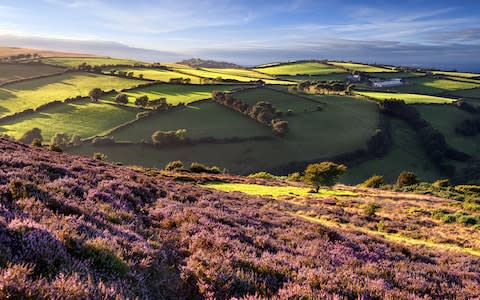This charming, quaint (and crowd-free) English village will win your heart

The name Dunster may sound an awful lot like 'dumpster', but don’t let the name deceive you. With its wide high street of colour-washed medieval cottages set against the backdrop of a red-sandstone turreted castle and thickly-wooded hills, Dunster is one of those visually flawless showpiece English villages that cause American visitors to coo with delight. Except you’ll be thrilled to learn that Dunster doesn’t welcome that many overseas visitors, as it’s tucked away up in the north-eastern corner of Exmoor, the least visited of all Britain’s national parks.
The busiest the village gets is for the Dunster Show (thedunstershow.co.uk), this year on Aug 17. The long-established annual agricultural event takes place in the very scenic setting of the castle’s grounds, with entertainment ranging from cattle and sheep parades to ferret racing.
The rest of the year it’s pretty easy to escape the crowds, particularly if walking is your thing, with the surrounding woods and moorland just a short, direct hike away.

Shouldn’t I start in the village?
Absolutely. Start on the High Street by the Yarn Market where you’ll find a splendid octagonal timber-framed construction erected in the early 1600s when Dunster was an important centre for the cloth trade. Just down the street is the small yet engaging Dunster Museum (discoverdunster.info; free) where you can learn about the village’s medieval heyday to your heart’s content. Upstairs you’ll find a splendid example of British eccentricity – a large, eclectic collection of dolls that includes everything from Kermit the Frog to Henry VIII and his six wives.
Back on the High Street, skip past the multiple tea rooms and head up to Dunster Castle (nationaltrust.org.uk/dunster-castle; adults £11.60, children £5.80). Though Norman in origin, what you see is mostly Jacobean and Victorian – the castle was converted into a comfy country home in the 1860s. Interior highlights include a 17th-century staircase intricately carved with hunting scenes, and rare Dutch leather wall hangings depicting the story of Anthony and Cleopatra.
Equally enjoyable are the surrounding gardens, which rise above the castle to an oval-lawned keep, and descend to bosky areas by the river Avill, with towering sequoia trees and giant rhubarb. The riverside path leads to a working watermill (same ticket as castle and gardens), where you can purchase wholemeal flour made on-site.
Great British Getaways | Discover more
Back in the village centre, pop into St George’s Church to admire its late-15th-century rood screen – thought to be the longest in England and topped with delicate fan vaulting – and the plentiful monuments to the Luttrells, who for many centuries ruled the roost in the castle and the feudal village. Then slip behind the church to admire its glorious walled memorial garden, the quaint, circular stone dovecote (you can peer inside), and a big and handsome tithe barn (restored as a community centre). All of this was part of Dunster’s Benedictine priory up to the dissolution of the monasteries in the 1530s.
I’m ready for that walk now
Cross the Avill by means of Gallox Bridge, a photogenic packhorse affair, then climb steeply through the dense woodland of the castle’s deer park up into Exmoor’s open moorland. Superlative 360-degree views, including over the Bristol Channel to Wales, are your reward – plus, if you want more history, the still-visible ditches of Bat’s Castle, an Iron Age hill fort. To make the outing into a longer circular route (two to three hours), fork out 30p for the Gallox Hill walking leaflet in Dunster’s national park visitor centre (exmoor-nationalpark.gov.uk).
If you want to enjoy the outdoors without the exertion, about five minutes’ drive from the village there’s Dunster Beach, a beguiling, low-key slice of English seaside with a mix of shingle, pebbles and sand; Second World War pillboxes; a friendly, few-frills café; closely-packed chalets; and a sea which at best invites paddling, but not swimming. For a more mainstream bucket-and-spade experience, head just along the coast to Minehead.
Dunster | Know before you go
Alternatively, set off from the ridiculously quaint Dunster Station, not far from the beach, on a steam train along the West Somerset Railway heritage line. From Dunster, the most popular destination is the sleepy old port of Watchet, 27 minutes of puff-puffing away (west-somerset-railway.co.uk; adults £10.80 return, children £5.40 return).
Any good nosh other than cream teas?
Indeed. Reeves Restaurant (reevesrestaurantdunster.co.uk; mains from £18), a hands-on, husband-and-wife business on Dunster’s High Street, is the standout dining spot by some margin. Expect substantial and creative dishes using plenty of locally sourced ingredients – maybe wood pigeon breast with a zingy fennel and chilli salad, or lamb accompanied by filo rolls filled with spinach and anchovy. Arrive in time to have a pre-dinner drink in the lovely garden.
Best of the cafés and tea rooms is Chapel House (chapelhousedunster.co.uk), in a brightly decorated former Methodist chapel on pretty but often overlooked West Street. Look no further than the moreish cheddar and parsley scones (from £3.25) if you want something savoury.

Any historic digs?
The Luttrell Arms Hotel (telegraph.co.uk/tt-the-luttrell-arms-hotel; doubles from £110 with breakfast), opposite the Yarn Market, dates from the late 15th century and is all ancient beams and panelling. The large walled garden is enticing in good weather, when it’s used for drinks and teas.
It serves good breakfasts and is very dog-friendly – a basket of old towels to clean muddy paws, a booklet of local dog walks, and you can take your pooch through a gate at the back of the garden into the castle’s parkland.
The Best of Exmoor (thebestofexmoor.co.uk) offers good-looking, inspected self-catering in Dunster (two-bedroom cottages from £385 a week; weekend rentals also available).
Win a luxury holiday worth up to £80,000

